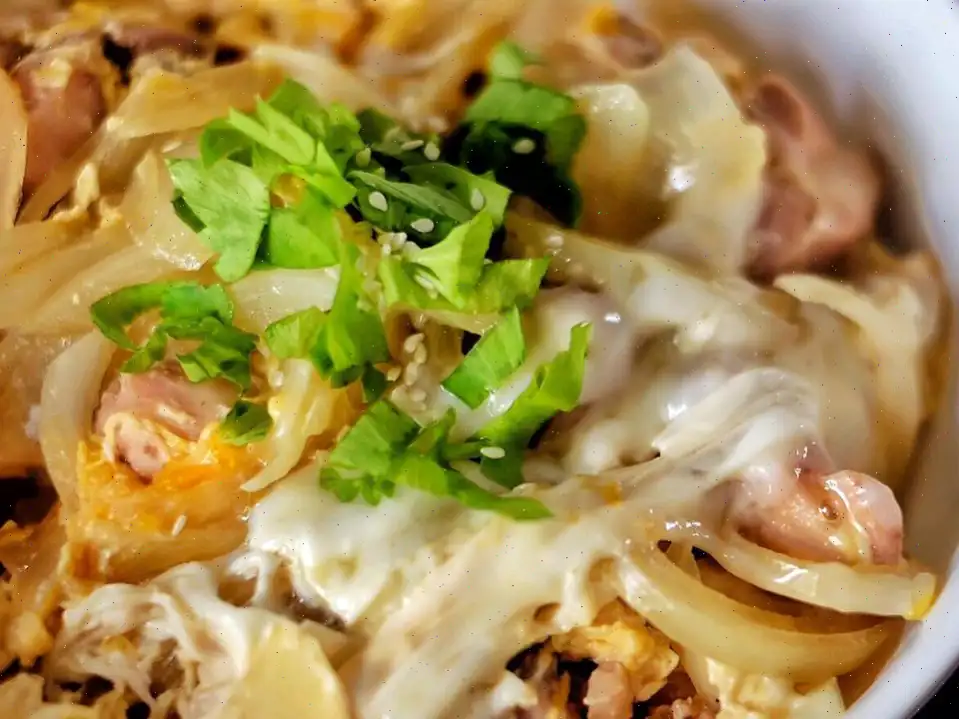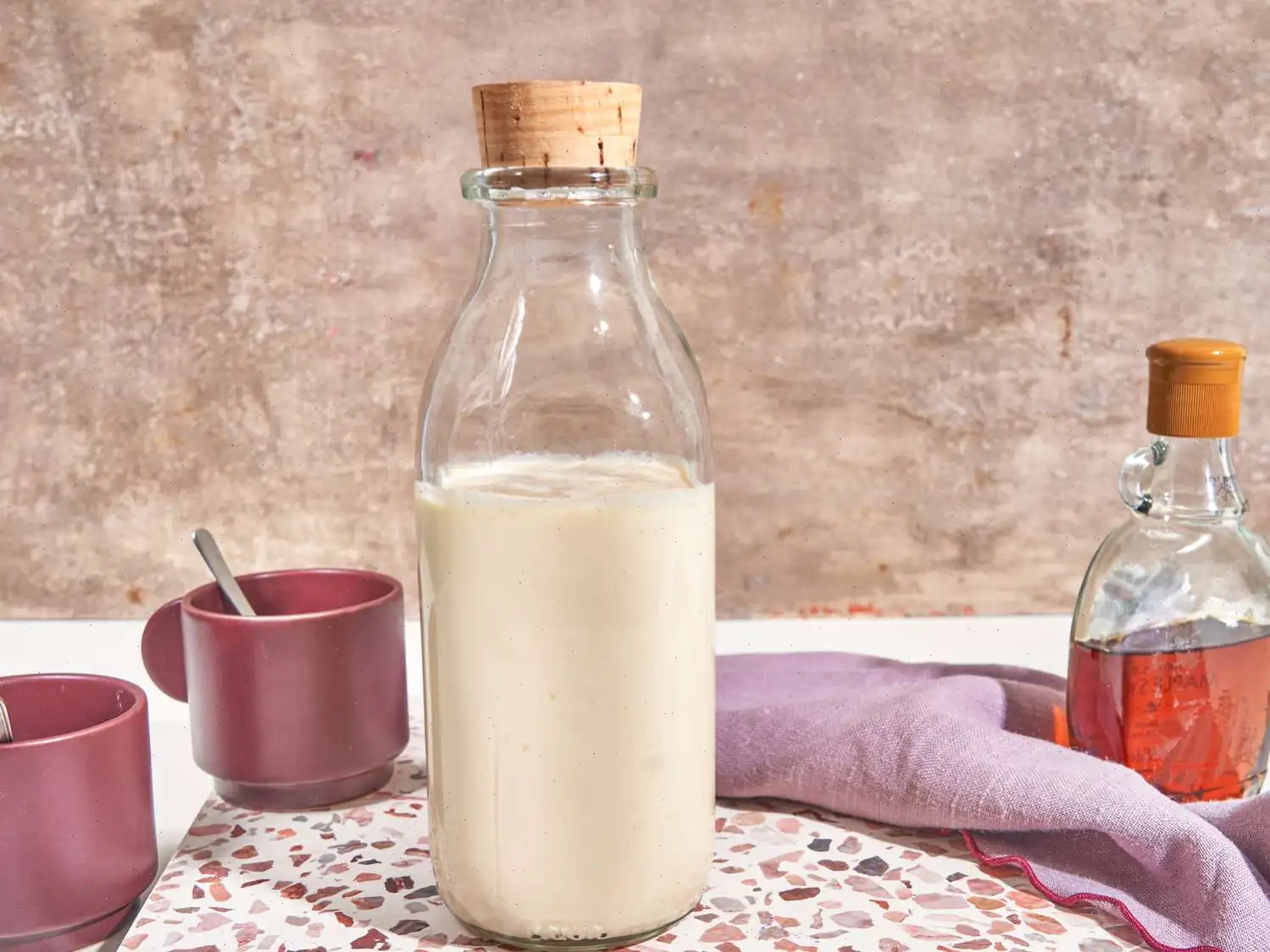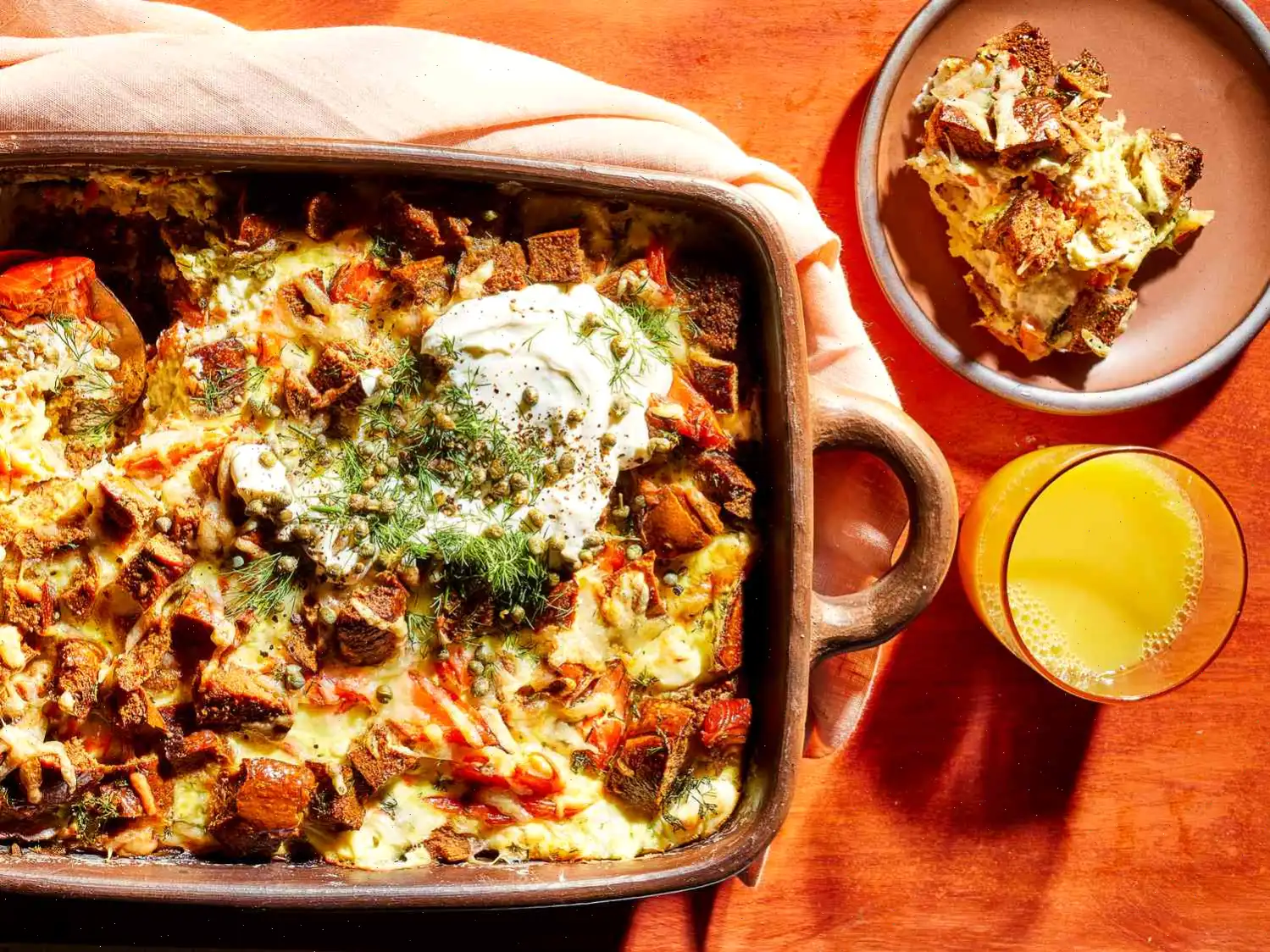
Oyakodon (Japanese Chicken and Egg Rice Bowl) Recipe
Ingredients
- 1 tablespoon olive oil
- 4 skinless, boneless chicken thighs, cut into small pieces
- 1 onion, cut in half and sliced
- 2 cups dashi stock, made with dashi powder
- cup soy sauce
- 3 tablespoons mirin (Japanese rice wine)
- 3 tablespoons brown sugar
- 4 large eggs
- 4 cups hot cooked white rice
Directions
- Heat oil in a large skillet over medium heat. Add the chicken pieces and cook until they begin to brown, approximately 5 minutes.
- Add the sliced onion to the skillet and cook, stirring occasionally, until the onion becomes translucent, about 5 minutes.
- Pour in the dashi stock, followed by the soy sauce, mirin, and brown sugar. Stir the mixture until the sugar dissolves completely.
- Bring the mixture to a boil, then reduce the heat and let it simmer for about 10 minutes, allowing the flavors to meld and the sauce to reduce slightly.
- In a separate bowl, whisk the eggs until well-beaten. Carefully pour the eggs into the hot stock mixture, stirring gently.
- Cover the skillet and reduce the heat. Let the mixture steam for about 5 minutes, or until the eggs are fully cooked.
- Remove the skillet from the heat. Divide the hot cooked rice among 4 deep soup bowls and ladle the chicken and egg mixture over the rice.
Nutrition Facts (per serving)
- Calories: 688
- Fat: 15g
- Carbs: 98g
- Protein: 35g
- Saturated Fat: 4g
- Cholesterol: 208mg
- Sodium: 1226mg
- Dietary Fiber: 2g
- Total Sugars: 17g
- Vitamin C: 4mg
- Calcium: 80mg
- Iron: 3mg
- Potassium: 510mg
* Percent Daily Values are based on a 2,000 calorie diet. Your daily values may be higher or lower depending on your calorie needs. Nutrient information is based on available data, but may not be complete for all ingredients. If you have dietary restrictions, consult your doctor or nutritionist before preparing this recipe.

History and Origin of Oyakodon
Oyakodon, also known as "Parent and Child Bowl," is a comforting and popular dish in Japanese home cooking. The name "oyako" translates to "parent and child," a reference to the dishs main ingredientschicken (the parent) and egg (the child). It is believed that Oyakodon originated in the early 20th century, in the bustling Tokyo district of Nihonbashi. The dish was created as a quick, easy, and affordable meal, reflecting the fast-paced nature of urban life in Japan during that era. Today, it remains a beloved comfort food in Japan, found in both homes and restaurants across the country.
Regional Variations
Though Oyakodon is popular throughout Japan, different regions have put their own spin on the dish. In the Kanto region (which includes Tokyo), the dish is traditionally made with a sweeter dashi broth, while in the Kansai region (including Osaka and Kyoto), the broth tends to be lighter and less sweet. Some variations may include additional ingredients such as mushrooms, tofu, or vegetables like peas or carrots. In some parts of Japan, the dish is served with a side of pickles or miso soup, further enhancing its comforting qualities.
How Oyakodon Differs from Similar Dishes
Oyakodon is often compared to other Japanese rice bowl dishes, such as Katsudon (breaded and fried pork cutlet with egg) and Donburi (various meats or vegetables served over rice). What sets Oyakodon apart is the use of eggs cooked directly in the dashi stock with chicken, creating a rich and velvety texture that distinguishes it from other donburi dishes. Unlike the crispy textures in Katsudon, Oyakodon relies on a soft, tender combination of chicken and egg, making it a perfect comfort dish for any time of day.
Where Oyakodon is Typically Served
Oyakodon is often found in casual eateries, such as izakayas (Japanese pubs), fast food joints, and family-run restaurants across Japan. It is also a staple in many home kitchens, where its made quickly with just a few simple ingredients. The dish is commonly enjoyed as a satisfying lunch or dinner, but it is also sometimes served as a comforting breakfast. In Japan, many restaurants offer Oyakodon as a set meal, served with a bowl of miso soup, pickles, and sometimes a small salad.
Interesting Facts About Oyakodon
- Oyakodon is considered a "one-bowl meal" in Japan due to its simplicity and convenience. It typically includes all the necessary components for a balanced mealprotein, rice, and vegetables.
- In Japanese culture, the combination of chicken and egg in Oyakodon symbolizes the relationship between parent and child, reflecting a deep sense of family and nurturing.
- Although its a traditional dish, modern variations of Oyakodon have emerged, with some chefs adding ingredients like mushrooms, spinach, or even different types of meat, such as beef or pork.
- Oyakodon is sometimes referred to as a "comfort food" in Japan, especially enjoyed during stressful times or after a long day, as it provides a sense of warmth and familiarity.
FAQ about Oyakodon (Japanese Chicken and Egg Rice Bowl) Recipe
Comments
LSUTiger
10/06/2025 01:52:54 PM
This is the ORIGINAL Oyakodon recipe! If you can't find dashi, try putting fish stock instead of chicken. Dashi are little dryed fish turned into powder...! By the way, did you know that "Oyako" means "Parents and Children" (in this case, chicken and eggs); don is just the word used for "rice bowl" ;)
Leiura
05/06/2018 11:12:42 PM
This is such a bomb recipe! My family and I came back from a month long trip to Japan recently and we were missing the food like crazy! But due to construction going on at the house we didn't have full access to the kitchen so we looked up an easy Japanese recipe and found this. Super delicious! The first time I followed the instructions exactly as they were written. The second time I set the yolks off to the side instead of mixing them with the whites, and I cut up some green onions for garnish. It tasted it even better! This is definitely a recipe that I'll be coming back to time and time again. Amazing flavor and super easy to make. Thanks!!
raindropz
01/06/2015 06:22:24 PM
Tastes great, but it's much too sweet and personally it was too much soup as it doesn't really reduce. I'd cut back to 1tbsp brown sugar, 2 tbsp soy sauce, 1 cup dashi stock (used half a tbsp dashi powder for it), and it's perfect. I also pan fried the chicken pieces with some salt and white pepper for a bit more flavour. Top with some green onions and serve.
AUSTAD
01/20/2016 07:12:58 PM
This was incredible, and I didn't even have any dashi. Normally I have some miso or dashi miso on hand, but I had to use chicken broth this time. I halved the brown sugar, as my mirin is pretty sweet already. For soy sauce, I only ever use Tamari, unless the recipe specifically calls for light shoyu or some other weird variety. I also used Tsuru Mai brown rice instead of the jasmine, made in the rice cooker. After it was dished up, the people that like spicy food sprinkled some Nanami Togarashi on it for a little kick. My guess is that this might actually freeze quite well after being dished up. If so, it would be great for quick lunches/dinners.
hwntradewinds
03/18/2012 08:10:54 PM
Great recipe, except for the Jasmine rice. Use Calrose instead. When we make this, we rehydrate dried shiitake mushrooms and use the soaking water for part of the dashi. It gives it a boost of flavor. Then slice the shiitakes (discarding the stems) along with some bamboo shoots and add with the onions when cooking. My mom was born and raised in Japan. As a child, this was one of my favorite dishes. I still enjoy it today.
SillyDonut5055
01/22/2024 12:27:44 AM
My husband and I liked this dish and I will make it again. I do think it needs more onions. Your photo looks a lot more oniony than mine (I used a large onion). Based on comments, I will omitted brown sugar. Also based on comments, I added mushrooms. While it probably is not traditional, I added garlic paste, ginger, and shichimi togarashi seasoning. Served over brown rice. Garnished with chopped scallions and shredded savoy cabbage. I only gave the recipe 4 stars because I thought it was bland as written.
Mystis
02/22/2017 03:34:43 PM
This was delicious and easy to make, though next time I will double the broth as most of it seemed to evaporate while simmering as my stove-top has a high-heat simmer. I suggest adding a vegetable like sauteed carrots, and seasoning it with garlic or curry powder. I had to substitute in chicken stock for the dashi as my family is allergic to seafood and white wine instead of mirin (it was all I had) but it was still wonderful and I will definitely make this again.
Nonnisaysmangia
08/24/2018 01:35:21 AM
very nice dish. i made my own dashi and added peas and sliced mushrooms and used a short grain rice; otherwise followed recipe. My family enjoyed it.
Dano
09/10/2017 07:20:06 PM
Delicious and easy (though time consuming). I made dashi stock from scratch because I couldn't find it locally. I followed the recipe almost exactly and the results are awesome. It took almost 10 minutes to cook most of the pink from the chicken, but then you saute it with the onions and then the stock for 15 minutes so undercooking the chicken isn't likely. Following another reviewer's suggestion, I only cooked the egg for 3 minutes so it stayed creamy and fluffy.
Carolie
03/18/2012 08:16:25 AM
Great recipe -- thank you! If you want to be truly authentic, please use Japanese medium or short grain rice, not jasmine rice, and leave the egg slightly runny. The texture really is quite different, both with the runnier egg and with the Japanese rice. Also, dashi is a light, delicious broth made from kombu (kelp) and katsuobushi (flakes of dried bonito). It's very easy to make. You can get the ingredients, or dashi powder, at any Asian market or in the international aisle of high-end grocery stores. Dashi is NOT powdered little dried fish!
Joey Pontanilla
02/20/2019 05:08:39 PM
Thanks for the recipe. It turned out great. I added a little more soy sauce and less brown sugar because I prefer a slightly more savory taste. I also added chopped shiitake mushrooms and flavored the eggs with curry powder for more flavor punch. Lastly, I topped it with a pinch of furikake. Itadakemasu!
Isabella
09/18/2025 07:44:06 AM
Amazing! I have made this multiple times and it always pleases everyone!
Tyler
08/31/2025 04:42:22 AM
I do NOT infact cook, I used this recipe for a scene in fanfiction.. looks really tatsy tho..!!
Diane Lee
02/21/2025 06:00:28 AM
Turned out perfect the first time.
ProGoat1751
01/25/2025 03:06:05 PM
Delicious but would half the amount of stock as ended up with a frying pan of soup.
Daniel Nauschuetz
12/18/2024 11:31:38 PM
Delicious and easy to make. It is a little light on seasoning, but that may be design. I certainly enjoyed.
OldBao4551
12/16/2024 11:18:53 PM
I use this recipe all the time. It reminds me of home--Maui, Hawai`i.
SRTGADabbler
10/09/2023 02:47:15 AM
This was really tasty! Not sure what I did wrong but I had way too much sauce! I had to remove a bunch before I added the egg. Added green onions when serving. Yummy!
ShinySpam7679
08/15/2023 09:21:01 AM
This was way too sweet. Inedible. Is it meant to teaspoons rather than tablespoons?
GoldMilk2295
07/20/2023 04:34:56 PM
I've made this many times and it's always a hit! The base recipe is good, but I also like to add in carrots and shiitake mushrooms with the onions for an extra kick of flavor.








